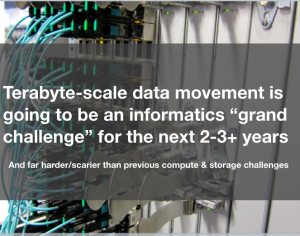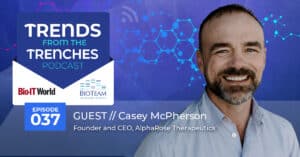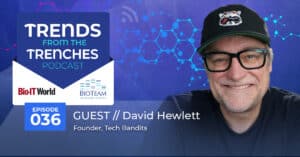May 18, 2015
2:00-4:00pm EDT
Background:
“Science DMZ” as a term has emerged to describe the philosophical, technical, operational and architectural foundation for how the high energy physics community has approached the problem of moving terabyte (or petabyte) data flows across local and remote networks.

The methods pioneered and adopted by the high energy physics community are broadly adoptable across other data intensive science disciplines and there is a significant and growing desire to apply this knowledge within the life science community.
BioTeam believes that the “Science DMZ” model represents the most viable design pattern for handling large-scale data flows within and among individuals and organizations involved in life science informatics.
The best source of information on the current state of Science DMZ progress can be found online at http://fasterdata.es.net/science-dmz/ — this is a great site to keep bookmarked and explore prior to the webinar event described below.
Event Information & Goals:
No marketing, no sales pitch, no BS. Our goal is to evangelize the ScienceDMZ concept and get the word out to a broader audience of IT and researchers working in the life sciences.
Experts in data intensive science from ES.NET will provide an overview of Science DMZ concepts and drivers. Other Science DMZ outreach events have been targeted to specific audiences or regional consortia members — our goal is no different. We want to convene the experts in one place to introduce Science DMZ methods and practices in front of a mostly life science audience.
This is the first in what will hopefully be a series of online events covering topics of interest to life science organizations involved in data intensive science. This initial session will present a basic overview of Science DMZ concepts and philosophy.
A significant amount of webinar time will be reserved for answering questions from the audience.
In future events we plan to showcase specific use-cases, reference architectures and design patterns currently being deployed in life science environments.
Featured Presenters
Eli Dart, Network Engineer, Science Engagement Group, ES.net
Eli Dart is a network engineer in the ESnet Science Engagement Group, which seeks to use advanced networking to improve scientific productivity and science outcomes for the DOE science facilities, their users, and their collaborators. Eli is a primary advocate for the Science DMZ design pattern, and works with facilities, laboratories, universities, science collaborations, and science programs to deploy data-intensive science infrastructure based on the Science DMZ model. Eli also runs the ESnet network requirements program, which collects, synthesizes, and aggregates the networking needs of the science programs ESnet serves.
Eli has over 15 years of experience in network architecture, design, engineering, performance, and security in scientific and research environments. His primary professional interests are high-performance architectures and effective operational models for networks that support scientific missions, and building collaborations to bring about the effective use of high-performance networks by science projects.
Jason Zurawski, Science Engagement Engineer, ES.NET
Jason Zurawski is a Science Engagement Engineer at the Energy Sciences Network (ESnet) in the Scientific Networking Division of the Computing Sciences Directorate of the Lawrence Berkeley National Laboratory. ESnet is the high performance networking facility of the US Department of Energy Office of Science. ESnet”s mission is to enable those aspects of the DOE Office of Science research mission that depend on high performance networking for success.
Jason’s primary responsibilities include working with members of the research community to identify the roll of networking in scientific workflows, evaluate current requirements, and suggest improvements for future innovations. Jason’s professional interests include network monitoring and performance measurement, high performance computing, grid computing, and application development. He is a founding member of several open source R&E software developments, including perfSONAR, OWAMP, BWCTL, NDT, and OSCARS.
Agenda
- Eli & Jason presenting ScienceDMZ (~30min) and perfSONAR (~30min)
- 60 minutes of Q&A




